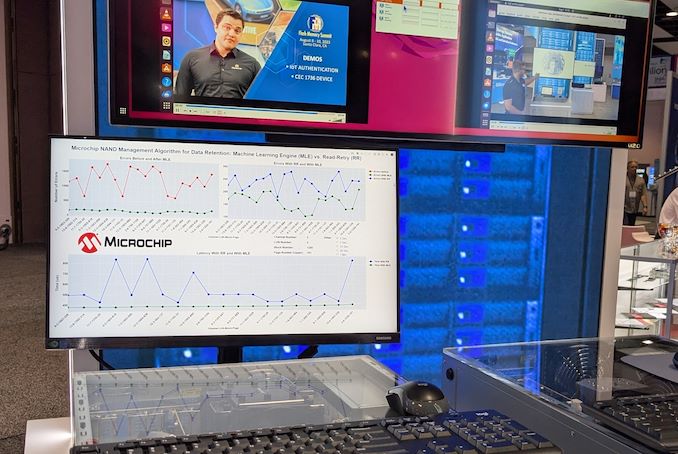Microchip Demonstrates Flashtec 5016 Enterprise SSD Controller
by Ganesh T S on August 8, 2024 5:30 PM EST- Posted in
- Storage
- SSDs
- Enterprise SSDs
- Microchip
- FMS 2024

Microchip recently announced the availability of their second PCIe Gen 5 enterprise SSD controller - the Flashtec 5016. Like the 4016, this is also a 16-channel controller, but there are some key updates:
- PCIe 5.0 lane organization: Operation in x4 or dual independent x2 / x2 mode in the 5016, compared to the x8, or x4, or dual independent x4 / x2 mode in the 4016.
- DRAM support: Four ranks of DDR5-5200 in the 5016, compared to two ranks of DDR4-3200 in the 4016.
- Extended NAND support: 2400 MT/s NAND in the 4016, compared to the 3200 MT/s NAND support in the 5016.
- Performance improvements: The 5016 is capable of delivering 3.5M+ random read IOPS compared to the 3M+ of the 4016.
Microchip's enterprise SSD controllers provide a high level of flexibility to SSD vendors by providing them with significant horsepower and accelerators. The 5016 includes Cortex-A53 cores for SSD vendors to run custom applications relevant to SSD management. However, compared to the Gen4 controllers, there are two additional cores in the CPU cluster. The DRAM subsystem includes ECC support (both out-of-band and inline, as desired by the SSD vendor).
At FMS 2024, the company demonstrated an application of the neural network engines embedded in the Gen5 controllers. Controllers usually employ a 'read-retry' operation with altered read-out voltages for flash reads that do not complete successfully. Microchip implemented a machine learning approach to determine the read-out voltage based on the health history of the NAND block using the NN engines in the controller. This approach delivers tangible benefits for read latency and power consumption (thanks to a smaller number of errors on the first read).
The 4016 and 5016 come with a single-chip root of trust implementation for hardware security. A secure boot process with dual-signature authentication ensures that the controller firmware is not maliciously altered in the field. The company also brought out the advantages of their controller's implementation of SR-IOV, flexible data placement, and zoned namespaces along with their 'credit engine' scheme for multi-tenant cloud workloads. These aspects were also brought out in other demonstrations.
Microchip's press release included quotes from the usual NAND vendors - Solidigm, Kioxia, and Micron. On the customer front, Longsys has been using Flashtec controllers in their enterprise offerings along with YMTC NAND. It is likely that this collaboration will continue further using the new 5016 controller.
Source: Microchip











3 Comments
View All Comments
mariushm - Thursday, August 8, 2024 - link
May want to fix the title as soon as possible.dwillmore - Friday, August 9, 2024 - link
These are some confusing feature sets. The 5016 seems like it's the higher end member, but with only a x4 (or split x2/x2) PCI-E v5 interface, it's the slower of the two as the 4016 offers x8. But in all other ways the 4016 is the lesser of the two.erinadreno - Monday, August 12, 2024 - link
I think the enterprise cares more about density than throughtput especially after applying some redundancy calculation. PCIE x8 is only theoretically supported by EDSFF connector ifrc. Using half the lanes means it can also be put in the same chassis with ordinary U.2 connectors.